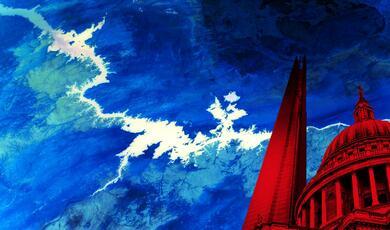Health after Earthquakes, Volcanoes, Tsunamis
Share
- Details
- Text
- Audio
- Downloads
- Extra Reading
Major geophysical events such as earthquakes, tsunamis and volcanoes can occur with little or no warning and have catastrophic effects.
This lecture will consider the health impacts of these natural disasters and how best to minimise them.
Trauma often dominates the first days after the initial event but predicting the medium-term effects such as infectious diseases can head off predictable secondary health disasters over the medium and long term.
Download Text
Health after earthquakes, tsunamis, volcanoes
Professor Christopher Whitty
20 February 2024
The geophysical emergencies of earthquakes, tsunamis and volcanoes can be highly destructive. There are immediate, short/medium term and longer-term health risks and impacts. Most are local to the event, but the effects can extend over long distances after large events. Responding effectively requires a basic understanding of principles of seismology and volcanology. This is a summary of the issues covered rather than a transcript of the lecture in full.
Earthquakes and volcanoes of relevance to health most likely occur when two tectonic plates meet. Many of the major earthquakes and volcanoes are under the sea; important ones for human health occur on land or near land in the great majority of cases.
Earthquakes
Earthquakes happen when tectonic plates slowly move in opposite directions. This leads to a gradual buildup of stress over years, decades or indeed centuries. An earthquake happens when a Faultline between plates has been locked and as the plates move stress steadily builds up and then is suddenly released in a movement or series of movements before the fault locks again. Geology is usually more complex than a single faultline, and this has implications for the level of destruction and consequent health impacts. Earthquakes occur every day and, in many places, but most are small with minimal or no destruction. For example, the UK, which is not prone to major earthquakes, has frequent tremors which have no health impacts and are seldom felt even by those near the epicentre.
Major earthquakes are however highly destructive. Since 1900 between 2 and 2.5 million people have died in earthquakes. Major earthquakes can lead to tens of thousands, or in the worst cases, hundreds of thousands of people dying. Many more are left injured or homeless.
It is possible to predict with moderate accuracy where severe shaking is most likely and there are maps to illustrate this. An example is the European seismic hazard and risk model ESHM20. Ground shaking is expressed as Peak Ground Acceleration (PGA). It is however impossible to predict when a major earthquake will occur until just before the event, if at all. A European example was the tragic earthquake in Aquila, Italy in 2009. 308 people died. Six scientists were tried for manslaughter on the basis they had given misleading information about the likelihood of an earthquake. Most scientists consider expecting accurate forecasting of the timing of an earthquake a misunderstanding of the unpredictability of events; predicting the timing of earthquakes is exceptionally difficult. Previous major earthquakes were recorded in Aquila in 1315, 1349, 1452, 1501, 1649, 1703, 1706, and 1958.
The immediate health effects of earthquakes are trauma, crush injuries and often fire. The biggest immediate risk is usually from buildings collapsing. These can lead to people being buried in the rubble, and also people being injured severely or moderately from falling masonry. There is usually a much lower risk for those in the open when the earthquake occurs. Whilst buildings are by far the biggest risk, natural hazards include cliffs and any other feature which can fall if shaken very severely.
In addition to trauma from physical impact are the effects of fire. In the San Francisco earthquake of 1906, there were over 3000 deaths but 90% of the physical destruction was probably from fire due to ruptured gas mains being ignited.
The advice for those experiencing an earthquake is easily summarised: drop, cover, hold on. People should drop to the ground. They should get under cover which may well be a sturdy desk, table or even a chair. They should hold on since both they and the cover will be shaken severely. Rooms with no windows are usually safer for those indoors although if you are outdoors and well away from buildings, that is safer still. There will almost certainly be aftershocks, some of which may occur very quickly after the initial quake but many which may occur for days, weeks or indeed months later.
How much damage occurs, and therefore the health impacts that occur, is highly variable. Most obviously it will depend on the strength of the earthquake. Whilst most are small the main measures of severity of earthquakes are logarithmic. Most well-known is the Richter scale, but the moment magnitude scale is now more widely used. Below five, damage to any health is extremely unlikely. From seven upwards widespread damage is likely and health impacts will start to occur quite commonly. Above eight major damage is likely and substantial loss of life can be predicted. In addition to the initial quake the number and severity of aftershocks, and where they occur will have a big impact. The size of effect on health will depend on the distance from the epicentre. It will also depend on the depth of the initial quake, its amplitude, and whether the soil liquefies due to shaking. In addition to these factors which are essentially to do with the earthquake itself, human factors are important. Building design is absolutely critical; a building designed for a significant earthquake is far less likely to lead to human injury than one which is not. Inevitably population density also has an important part to play; a moderately severe earthquake in a built-up area is likely to lead to much higher health impacts than a very major earthquake a long way from significant human habitation.
The lecture will illustrate this with the example of the 2015 Nepal earthquake, a 7.8 Mw quake in which tragically around 9000 people died, more than 22,000 suffered injuries and over 3 million were made homeless. In this earthquake after-shocks were very important, they hit buildings and geological features weakened by the first shocks. After-shocks have psychological as well as physical impact since people cannot be sure whether the emergency is still ongoing. They also complicate recovery operations.
Earthquakes can have delayed effects. These include delayed after-shocks, landslides caused by weakening due to the quake, which may occur much later in particular when there are heavy rains in monsoons, and dams burst from landslides which have trapped water which then break through the rubble dam. Landslips, rockfall or avalanches occur where there is a gradient.
After the initial quake the immediate priorities are: Trauma care, search for survivors, providing clean water, shelter and warmth, especially in winter. Because major earthquakes are a sudden event, systems will invariably be overwhelmed. Transport in and out is also often very difficult (for example airports may be damaged) making relief efforts complicated.
Immediate healthcare needs are to treat trauma, crush injuries and inhalation injuries. Many of the injured will have healthcare needs familiar to those trained in first aid. These include fractures, soft tissue injuries, wounds, and burns. There may be inhalation damage from severe dust exposure. In more severe cases head injuries typically due to falling masonry will occur. An important part of medical care after earthquakes is due to crush injuries. These are much less commonly seen outside these kinds of emergencies. They can lead to shock (significant drop in blood pressure) due to leakage of fluids; electrolyte imbalance leading to cardiac arrest; acute kidney failure. Limbs or other areas which are trapped may have compartment syndrome which leads to very severe tissue destruction.
Medium term health effects after earthquakes, in days to months are also predictable. Earthquakes will lead to a loss of safe water and sanitation, making diarrhoeal diseases including cholera more likely. After the Haiti earthquake of 2010 there was a cholera outbreak following importation with over 820,000 cases and nearly 10,000 deaths. Water pooling may lead to vectorborne infections, and crowding may lead to increased risks of respiratory disease. There is also likely to be a breakdown in preventative services, maternity services, and curative medicine, all of which will have an impact on health indirectly. In serious earthquakes malnutrition and exposure to severe weather will also complicate responses and exacerbate health problems.
In the long-term, meaning months to years, earthquakes can have profound effects. Probably the most important is economic deprivation, which may be multigenerational, with people’s livelihoods taken away. In turn this can lead to exploitation of those who are now highly economically vulnerable. They will be psychological harm. There will be a backward step in healthcare, schooling, public services, and wider infrastructure which may be severe. There will also be long-term impacts from disruptive preventative services such as vaccination.
Reducing health harms from future earthquakes has to be done systematically. Mapping of areas at risk, both the macro scale (where likelihood of earthquakes is high) and the microscale. Mapping out critical infrastructure and transport bottlenecks can help with planning for predictable disasters. Engineering down the risk is entirely possible. In earthquake prone areas earthquake proofing buildings is a known area of engineering. It does, however, cost money. The same size earthquake in Japan or Haiti will produce much lower mortality in Japan because earthquake engineering standards are extremely high in this high-income country with a known risk. In lower- or middle-income countries it is sensible initially to concentrate on key structures where large numbers of people congregate including schools, hospitals, and public buildings.
Tsunamis
Tsunamis, which are very large waves, are only a risk in coastal areas but in those areas, they can have devastating impacts. 80% of tsunamis follow earthquakes, others are from volcanoes or landslides, and in the deep past asteroids have (and probably will) cause significant tsunamis. They cause a long wave which in deep water travels very fast, up to a thousand kilometres an hour. The wave is in the entire water column rather than just the top as is the norm for waves caused by wind. As it reaches shallower water near land the wave slows and grows. It can grow up to 30 m but often is more like a rising flood or rapid tide. Waves are immensely powerful; even 15 cm of water travelling at speed will knock an adult off their feet.
The worst recent, and indeed worst recorded example was the Boxing Day tsunami off Indonesia in 2004. An undersea 9.1 Mw earthquake occurred off the coast of Sumatra. The subsequent tsunami killed an estimated 227,900 people in 14 countries. Waves which were up to 30m high occur near the epicentre and it spread across the ocean with significant impact on Indonesia, India, Sri Lanka, and low-lying islands among others. The wave took two hours to reach India and 7 hours to reach Africa. The warnings for tsunamis which occurred in this case as in others are the earth shaking and water receding very fast. There are now more extensive tsunami warning systems than were present then. If any of these occur the key is to get to high ground very fast.
The 2004 tsunami was the worst in recorded history. There have however been important tsunamis described throughout history. One that impacted Europe was the Lisbon tsunami of 1755 which affected Portugal, the Azores, North Africa, France and in the UK Cornwall, where waves were likely up to 3 m with ‘great loss of life’. Major landslides in Norway or the Canary Islands are theoretical risks of major tsunamis to the UK. There are potential risks for most countries with coastlines.
The immediate potential health impacts of tsunamis include drowning, trauma from debris washed rapidly through the water, and infection from contaminated water. In the longer-term destruction of safe water and sanitation is likely with consequent infectious diseases, pooling of water may lead to vectorborne diseases, and destruction of homes and livelihoods may have substantial economic and social impacts.
Many emergencies are composite. An example is the 2011 Fukushima disaster. The start was an earthquake where the nuclear plant shut down automatically and correctly. There was, however, a subsequent tsunami. This led to nuclear meltdowns with the release of nuclear material.
Volcanoes
There are over 1500 active volcanoes on Earth, with 82 in Europe. They occur near tectonic plates which are diverging or converging. There are significant risks close to erupting volcanoes but also potential risks from some volcanoes over much greater distances. Whilst earthquake risks are carried over a distance by land, tsunamis by water, volcano risks are largely carried by air.
Health risks near volcanoes depend on the volcano type. The most obvious is lava flow. This is spectacular and dangerous because it is extremely hot but relatively slow in most cases. Tephra, which includes ash, but also much larger particles up to rock-sized objects including pumice from the eruption may fall around the volcano from a great height. Falling ash can be a significant weight near volcanoes and collapsing buildings. An example was Herculaneum, buried under volcanic ash and pumice in the eruption of Mount Vesuvius in 79 A.D.
The next risk is pyroclastic flow. Hot gases and debris can flow down mountains at over a hundred kilometres an hour maintaining a temperature of over a hundred degrees centigrade. Separately lahars may occur; volcanic debris and water/mud flowing at tens of kilometres an hour and burying everything in their path. There may be glacial outburst floods.
Gases are a substantial hazard near erupting volcanoes. CO2, hydrogen chloride, hydrogen fluoride, hydrogen sulphide, sulphur dioxide are examples of these. Many are heavier than air and therefore pooling in low-lying pockets.
Ash and gases can travel significant distances once lofted into the stratosphere and carried by winds. Often the risk is greatest to aircraft where ash can damage engines and sulphur dioxide can cause health problems. On occasions with major eruptions, however, the effects are more widespread. An example is the Laki eruption in Iceland starting in 1783. Hydrofluoric acid and sulphur dioxide gases contaminated the country, killing over 50% of livestock and leading to famine. Around 120 million tonnes of sulphur dioxide gas also spread over Europe and on one estimate 23,000 people died from sulphur dioxide poisoning in the UK. It led to a drop in temperature and probably affected climate in Africa and Asia leading to famines.
Massive volcanic eruptions have devastating local effects and affect climate and weather globally. The eruption of Mount Tambora, Indonesia in 1815 is estimated to have killed up to 120,000 people with local and global effects. Krakatoa in 1883 caused a series of tsunamis killing an estimated 36,000. More recently an eruption in Montserrat caused around two thirds of the population to leave the island.
In the longer-term effects can also be profound. The length of time volcanoes erupt is often underestimated as popular imagination tends to imply a single short eruption. It may be months or years. This can affect health from gases and ash, indirect effects for livestock and crop failures and destruction of infrastructure. It can have an effect on medium and short-term climate. It can lead to sudden loss of livelihood, shelter, and consequent longer term health impacts. They can also have psychological effects.
Geophysical emergencies, specifically earthquakes, tsunamis and volcanoes can therefore have very serious health impacts. They are sudden, largely unpredictable as to when although more predictable as to where. They can cause massive loss of life. Initially critical injuries include trauma, drowning, and burns. Medium-term effects include infections, nutrition, preventative and curative health services, and psychological impacts. Longer-term effects include loss of livelihoods, shelter, and infrastructure.
© Professor Christopher Whitty, 2024
Part of:
This event was on Tue, 20 Feb 2024
Support Gresham
Gresham College has offered an outstanding education to the public free of charge for over 400 years. Today, Gresham College plays an important role in fostering a love of learning and a greater understanding of ourselves and the world around us. Your donation will help to widen our reach and to broaden our audience, allowing more people to benefit from a high-quality education from some of the brightest minds.


 Login
Login







